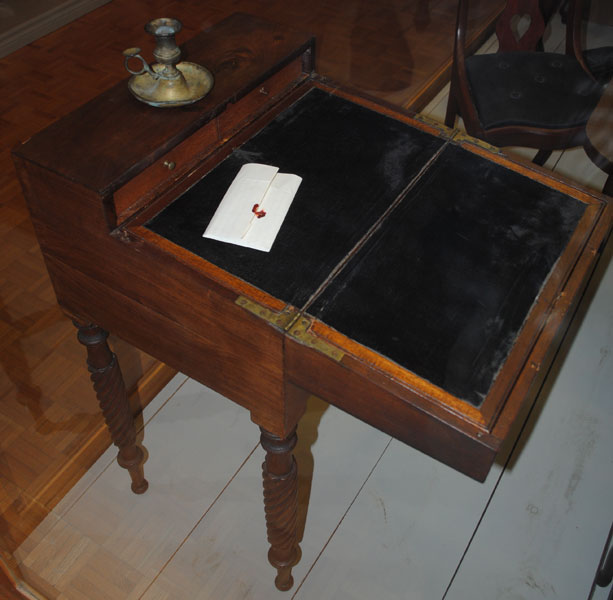
Borders & Frontiers (1800-1820)William Case's Writing Desk |
|||
|
|||
Early 19th Century writing desk used by Reverend William Case |
William Case was the eldest son of George Case, a farmer of English descent, whose family had immigrated to Massachusetts in the 17th century. In 1805, Case was admitted on trial as an itinerant minister by the New York Conference of the Methodist Episcopal Church and appointed to the Bay of Quinte circuit in Upper Canada. As a young preacher, Case served the Bay of Quinte Circuit in 1805-1806. DISCOVER MORE![]()
Case was ordained deacon in 1807 and elder in 1808. After a year on the Ancaster circuit (1808–9), he was asked to develop a new circuit in the lower Thames valley. In 1810, he became presiding elder of the Cayuga District in the newly created Genesee Conference.
During the War of 1812, he remained as a presiding elder in the United States, returning to Upper Canada in 1815 as presiding elder of the Upper Canada District which extended from Detroit to Kingston. As an American and a leading figure in the Genesee Conference, Case would have been suspect as an American sympathizer. Despite the wartime disruption, Canadian Methodism revived quickly after 1815, but tensions continued between the Methodist Episcopal ministers and Wesleyan missionaries from the British Wesleyan Conference. At the general conference of 1824, he argued for a separate conference in Upper Canada. Case served as a presiding elder in the new conference, and its secretary from 1824 to 1827.
When the General Conferences of the Methodist Episcopal Church convened in Pittsburgh, the 1824 memorial from the Hallowell (Picton) Conference, petitioning separation of the Methodist connection in Canada, was approved. The first Canada Conference after separation was held at Switzerville in 1828. Beginning October 2, Methodist preachers arrived in Switzerville for a week of meetings.
The Switzerville Methodist Chapel had been finished in time to be used for the site of the first Canada Methodist Conference. Switzerville was settled by a cluster of families with roots in the German Palatinate. Escaping war, economic difficulties and religious persecution, their Protestant ancestors had moved in 1709 from the Rhineland in Germany to Limerick County in Ireland and later to the Camden Valley in New York and finally to the Switzerville area. These families built the chapel at Swizerville once a deed for the land had been obtained in May 1825. The first trustees were Christopher and Elijah Switzer and Rufus Shorey, John Miller, John Madden, Stephen Warner and George H. Detlor. A Switzerville Chapel collection box still survives today.
At the Switzerville conference, the Methodist Episcopal Church in Canada was organized. Reverend William Case was elected general superintendent pro tempore and superintendent of the Conference's Indian missions. He was also named to a committee to improve relations with the British Wesleyans.
In 1832, the conference agreed to unite with the British Wesleyans. The Wesleyan Methodist Church in Canada was formed the following year. Case was appointed "General Missionary to the Indian tribes" and charged with translating the Scriptures into the Indian languages. He directed the church's mission to native peoples from his base at the Credit Mission and in 1836, established a community at Alderville near Rice Lake, similar to the community he had established on Grape Island in 1826. He died at Alderville in 1855 from injuries sustained when he fell from his horse.
Throughout his ministry, Case kept up a personal correspondence with his fellow workers, and wrote endless reports of the work for the press in both the U.S. and Canada. The drawers of his writing desk show ink stains and evidence of sealing wax. The desk may originally have been a side table to which the writing desk was added later. The table part with its beautiful spiral turned legs is the Empire period, probably made in the 1820's.
The desk was likely once filled with writing paper, quill pens and bundles of letters in the drawers. Many of William Case's letters were printed in the Christian Guardian, the Methodist Quarterly Review (New York), and its predecessors, the Methodist Magazine (1818–28) and the Methodist Magazine and Quarterly Review (1830–40).
© Lennox & Addington County Museum & Archives
97 Thomas Street East, Napanee, Ontario, Canada K7R 4B9
Funding provided by the Government of Ontario and the County of Lennox & Addington




